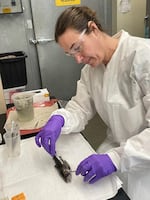Oregon officials have killed about 160,000 rainbow trout to stop the spread of a pathogen they hadn’t seen before.

A provided image of the raceway at Elk River Hatchery, which is used to raise rainbow trout
Oregon Department of Fish and Wildlife
Oregon Department of Fish and Wildlife staff discovered the parasite after they noticed rainbow trout at three hatcheries were dying at higher than normal rates. They tried antibiotics and other treatments, but the fish didn’t get better.
With help from Oregon State University’s College of Veterinary Medicine and the OSU department of microbiology, genetic testing found parasites in the class Myxozoa. Researchers determined that fish were infected with the pathogen that can spread through water and harm fish kidney and urinary systems.
The fish were 8 to 10 inches long by the time the pathogen was discovered at hatcheries in the Elk River, Rock Creek and Klamath Falls.
Although it’s the first time this parasite has been identified or linked to fish deaths in Oregon, ODFW staff say it’s probably been in the Pacific Northwest for some time.

In this provided image, ODFW senior fish pathologist Dr. Aimee Reed examines a rainbow trout affected by the parasite.
Oregon Department of Fish and Wildlife
“We know that high temperatures and low flows are more inviting for parasites like myxozoans to infect fishes,” Aimee Reed, aquatic veterinarian and ODFW’s senior fish pathologist, said in an emailed statement.
“Climate change is causing exactly these conditions so it could be playing a role in why we are seeing this parasite now,” she said.
The Oregon Department of Fish and Wildlife said it’s taken “biosecurity measures” to stop the parasite from spreading. That includes sanitizing ponds and raceways, and killing most of the infected fish.
They sent about 500 of the infected trout to a laboratory, where ODFW and OSU researchers hope to continue studying the parasite.
ODFW hatcheries raise and release close to 4 million rainbow trout each year and should be able to make up for most of the recent loss.
“This is a disappointing loss but allowing the parasite to spread could be much worse and put even more fish at risk,” Reed said in her statement. “Situations like this are why Oregon’s state hatcheries have vigorous biosecurity measures and monitoring programs.”
